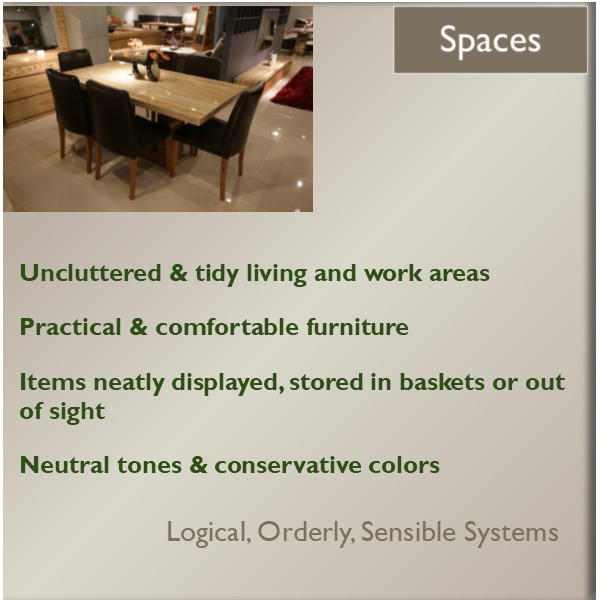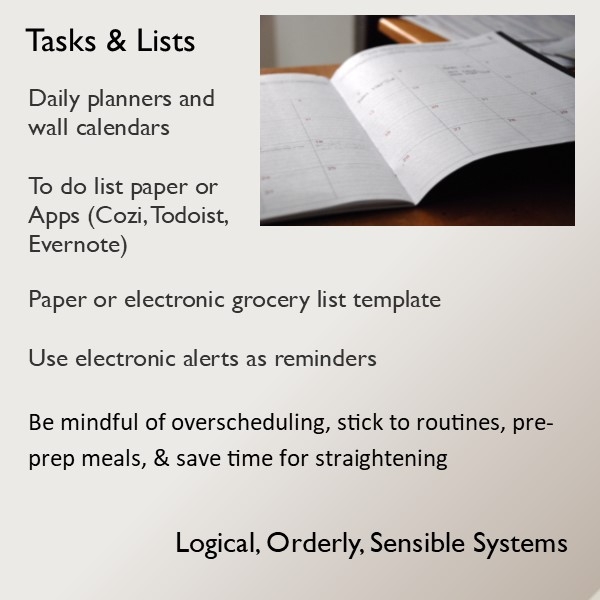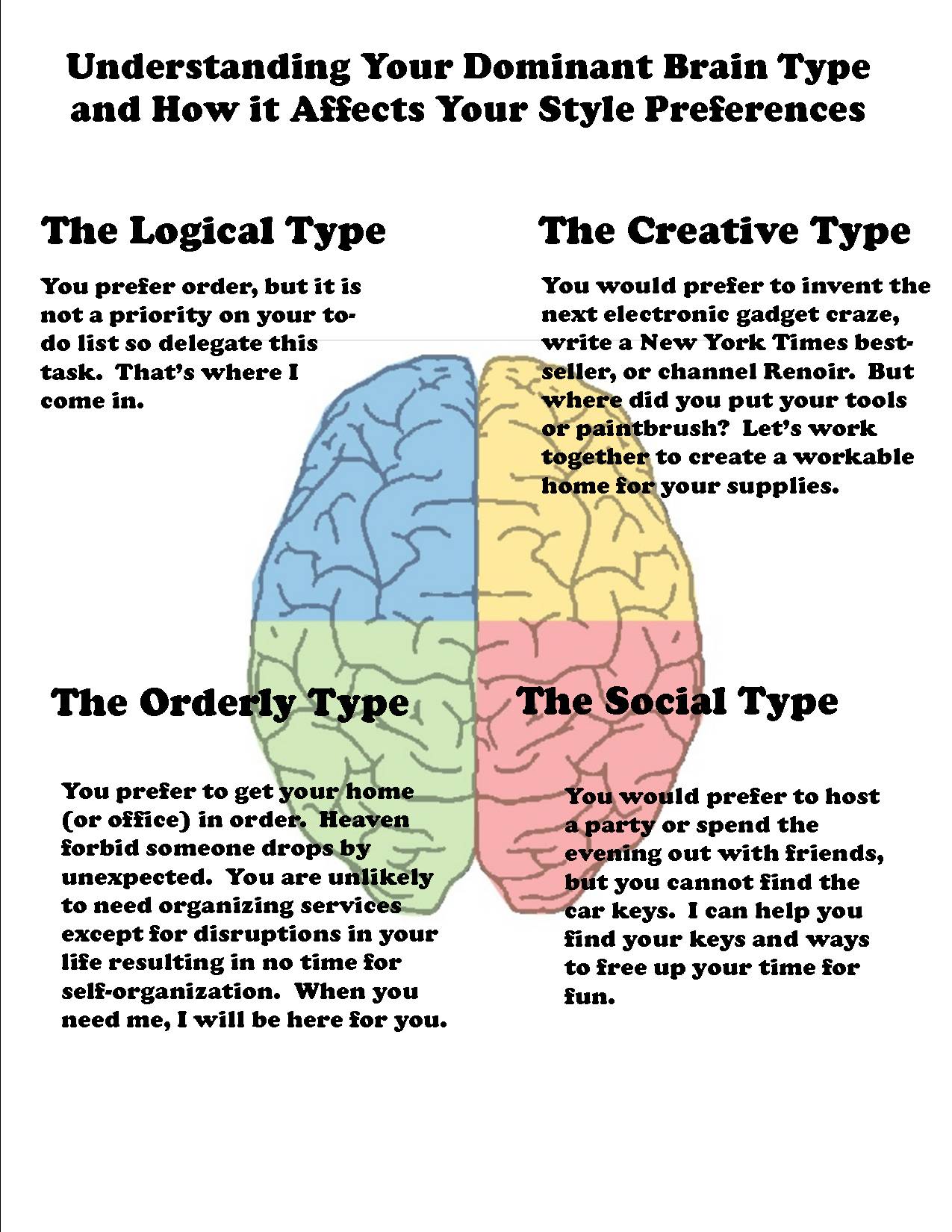Want to Make Your Life Easier?
Use Your Brain.
Why does life have to feel so hard sometimes?
Unfortunately, the world doesn’t stop until we can get it together. Although there is no adult ADHD cure, there are techniques to
How? Below you’ll find a sampling of tools to get your head wrapped around…your head.
This model is based off the Herman Brain Dominance Index. That’s the technical stuff. What you need to know is what makes you tick for optimal performance.
When it feels like each day is a new battle to get stuff done…
And…everyone else has it so together, why don't I?
And…I don't even know where or how to begin!
…Then it is time to try something different
Living in chaos and disarray is not fun
What are your options?
Where do we start?
First let’s learn a little bit about you. Knowing more about your brain type and sensory preferences can help you create a roadmap to results.
Get to Know Yourself Better
We draw from all parts of the brain (or at least we hope). Yet typically attributes of one side of the brain or one quadrant will stand out. These self-discovery assessments are oversimplified and overgeneralized indeed. However, you can use the results to create a roadmap to take meaningful action in a way that makes sense to you. We don’t all take the same routes to destinations. Your path is unique to you. Your toolkit will need to fit you.
Complete the form below to access 3 links designed to enhance your self-awareness. Please note: these assessments are not intended to represent a diagnosis. Information that you learn about yourself can be used as a conversation starter with your physical or mental healthcare practitioner. Scroll down to access additional national and Portland Metro Area resources for an evaluation, further education, and possible treatment.
Adult ADHD National & Local Resources
Looking for Adult ADHD educational, diagnostic or treatment resources? Click for a listing of national and Portland Metro Area Adult ADHD organizations and practitioner listings.
Click on the button below to download Reduce Head Clutter.
Suppose My Brain is Cluttered?
Regardless of your brain type and sensory preferences, the general tips that follow will help you get on track and stay the course.
For those gifted with ADD/ADHD, download this pdf to keep your ADHD brain in the game. Learn to work in harmony with peak performance times, enhance comfort, decrease distractions and other useful tips to relieve some of your stressors and increase your productivity. Download your copy now. Simply fill out the form and click on the link.
There’s a lot of information below. Here’s a way to avoid overwhelm. Once you know your brain type results, click on the corresponding link:
Logical
Orderly
Creative
Social.
Then proceed to sensory preferences. Sometimes it’s helpful to review other styles for more productive and harmonious personal and professional relationships.
Left Brain Tips
- Minimize time commitments and stuff to avoid overwhelm
- Stick to routines as much as possible
- Talk through difficult tasks to peel them apart
- Put things into context to create order out of chaos
- Process sequentially
- Neatly filed papers/file folders
- Use music or podcasts to stay motivated
- Use reminder alerts
- You see the details, but can miss the bigger picture, may need assistance for seeing the forest
Always busy, an admin, family members, a housecleaner or organizer are your saviors keeping your household running shipshape.
The Logical Types
Dominance in the left front brain region equates to a Logical/Executive personality inclination. Think of this as the CEO, financial analyst, or engineer.
Your strengths are:
Prioritizing goals and objectives
Fact-based problem solving and decision-making
Research and analysis
Delegating
Competition
Hard-work
Emotion management.
At work, you likely prefer the aid of an assistant to handle your administrative tasks while you attend to the bigger picture. At home, family members, a housecleaner or organizer are your saviors keeping the household running shipshape.
Arlene Taylor, Ph.D. provides some examples for how you might want to think about ordering your spaces in relation to your brain "bent" as she refers to it.
Logical Type Spaces
If you find yourself as a Logical Type or in the Prioritizing Division (as defined by Arlene) then your desirable environment and accessories might look like this:
Uncluttered
Colors: black, white, gray, and navy
Practical, comfortable furniture
Items stored neatly out of sight or in baskets/bins
Machines and mechanical tools
A computer for research projects
Scales and calculator
Charts containing numbers and percentages
Framed awards
Abstract photos of arrows
A list of goals and objectives
A five-year plan
Structured music (e.g., slow movements of Bach, Mozart, baroque compositions).
The Orderly Types
Dominance in the left rear of the brain renders an Orderly Type also known as the Maintaining style (the organizer, planner, administrator). Your strength is sequential routine activities. Calendars, journals, electronic alerts are your friends.
Calendars, journals, electronic alerts are your friends.
Your strengths are:
Predictable
Honest
Stable
Dependable
Methodical
Organized
Timely
If you are an orderly type, you are naturally organized, but when a situation occurs that throws you off balance i.e., a birth, death, divorce, new job, illness, home renovation project, then watch out. You can be easily overwhelmed, and might need a hand to get back on track.



Orderly Type Spaces
The Orderly Types desired environment and accessories include:
Uncluttered
Colors: neutral or subdued
Practical, comfortable furniture
Items stored neatly out of sight or in baskets/bins
Filing cabinets with labeled files
Desk with organizing bins and file sorters
To do lists, list templates to save time
Electronic or paper calendars
According to Dr. Taylor the music is of a more traditional style.
Right Brain Tips
- Avoid routine to stave off boredom
- Set mood or cerebral music to energize, center, or calm or podcasts
- Colorful, crafty files
- Use images for labeling
- Use Sticky Notes
- Allow yourself opportunities to re-envision your spaces to keep them interesting
- Draw out ideas, run them by others if you need reassurance
- Be mindful of odors or use pleasurable scents, essential oils
- See the whole picture more than details so stick with broad categories
The Creative Types
The Creative, Innovative or Envisioning Type finds their strength in the right front brain quadrant (the artist, composer, architect, interior designer, and so many more).
Your strengths are:
Could benefit from some snazzy visuals or fun storage ideas to ensure you get and stay organized?
Innovative
Expressive
Spontaneous
3-D imagery visualizer (often)
Imaginative
Artistic
Intuitive
Big picture spatial thinker
You know what you need is in that pile over there, but you may have a hard time putting your finger on it when you are in a rush to get out the door. Could benefit from some snazzy visuals or fun storage ideas to ensure you get and stay organized?
Creative Type Spaces
- Inspirational airy, unstructured spaces with plenty of flat surfaces for stacking
- Simple storage systems
- Funky, lidded bins to keep messes out of sight
- Fun, colorful furniture and decor
- Reading corner with a wide range of topics
- Large sheets of paper, pencils, erasers, and markers
- Cork boards to post notes & dry erase boards for jotting and doodling
Creative Type Time Management
- Work in short bursts
- Try artistic templates to spice up dull assignments
- Reward yourself with creative activities to inspire your brain
- Use Apps to create reminder lists
- Keep a colorful fun journal of to-dos and other thoughts & plans
- Set electronic alerts and reminders to stay on task
- Break frequently to refuel and recharge your brain and body
Keep in mind your friend is there to inspire, motivate, and invigorate not distract you from getting things done.
The Social Types
And lastly the right rear lobe is home to the Social/Harmonizing Type.
Personal connections are trademarks of this brain type (teacher, nurse, spiritual leader, community-outreach coordinator).
Your strengths are:
Peace
Spirituality
Goodwill
As a Social type, you prefer to work in friendly environments where you can chat with others, work at your own pace, and your nurturing side is sensitive to others feelings and well-being.
If you are struggling to find your way to organization or maintain it, then a buddy system would be your best bet to get things done. As long as you have company and maybe a glass of wine or cup of herbal tea, you are ready for action. Keep in mind your friend is there to inspire, motivate, and invigorate not distract you from getting things done.
Social Type Spaces
The spaces of the Social/Harmonizing type might look like this:
Colorful, cozy, and fun rooms
Photos of friends and family
Inspirational books and pictures
Plants, candles, and stuffed animals
Nature sounds
Musical instruments
Rhythmic, melodic music and music that tells a story
Where Do We Go From Here?
Sensory Preferences
We’ve nailed your brain type, what’s next? Let’s look at your sensory preferences.
Are you visually inspired?
An auditory processor?
A kinesthetic/tactile (hands-on) learner?
Working in accordance with how you process information means that you will not only learn it faster, you will be more likely to retain it and use it.
Most of us have elements of each of the 4 regions of the brain as well as each of the processing preferences, but we will want to align with where you draw your strengths to affect lasting changes. The task becomes a bit more interesting when meshing multiple types in one household or office. But no worries, there are ways to effectively manage multi-user spaces.
As mentioned above, in addition to dominant brain types, our sensory preferences equate to the types of sensing stimuli that our brain most rapidly and intensely recognizes and responds in kind. According to Dr. Arlene Taylor, author of the assessment used on this site,
“If two scores are tied, one of the scores likely represents your sensory preference, while the other represents
skills you’ve developed in order to relate to someone significant in your life. If one of the tied scores is
kinesthesia, consider the possibility that your innate preference is kinesthetic and that for some reason, you have increased skills in another sensory system.
If all scores are equal, you may have developed higher numbers of skills in other sensory systems due to lack
of opportunity to use your own preference, a perceived necessity to relate to a specific person or
environment, or because of being punished or shamed for your own preference. Use your scores as a starting point for evaluating your sensory history. Try to uncover and identify factors that may have pushed you away from your sensory preference.”
How does this apply to getting and staying organized? Here are some suggestions based upon each sensory preference.
These lists are not prescriptions for how you should decorate your rooms. Comfort and functionality should be top priorities for you and others sharing the space. Select your favorite piece of music or noise cancelling headphones. Let's get to work.
























